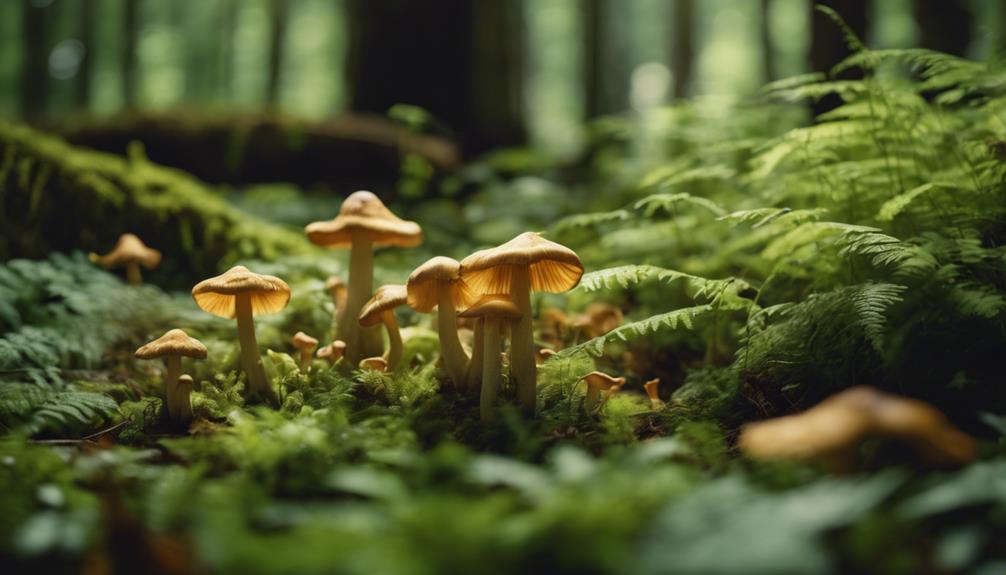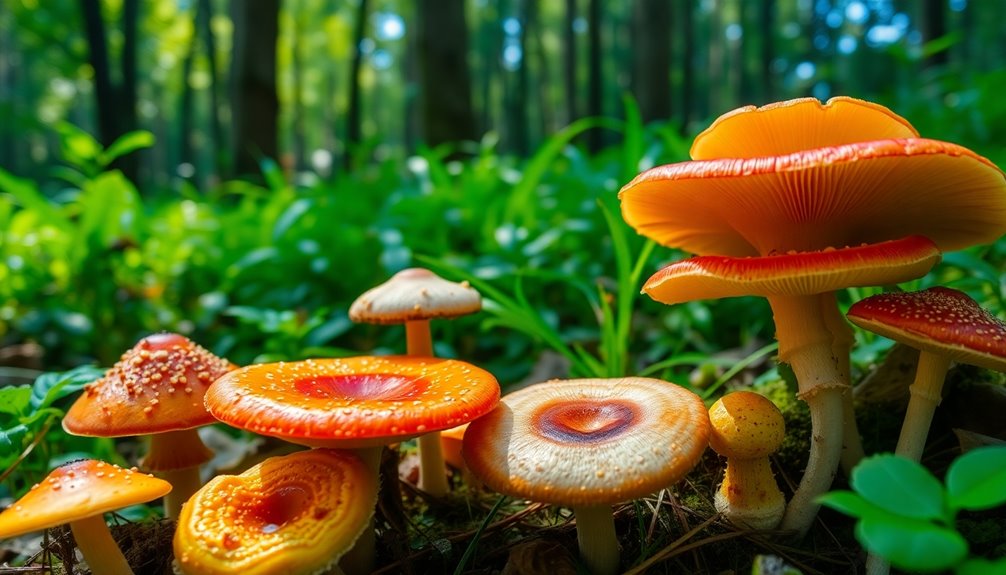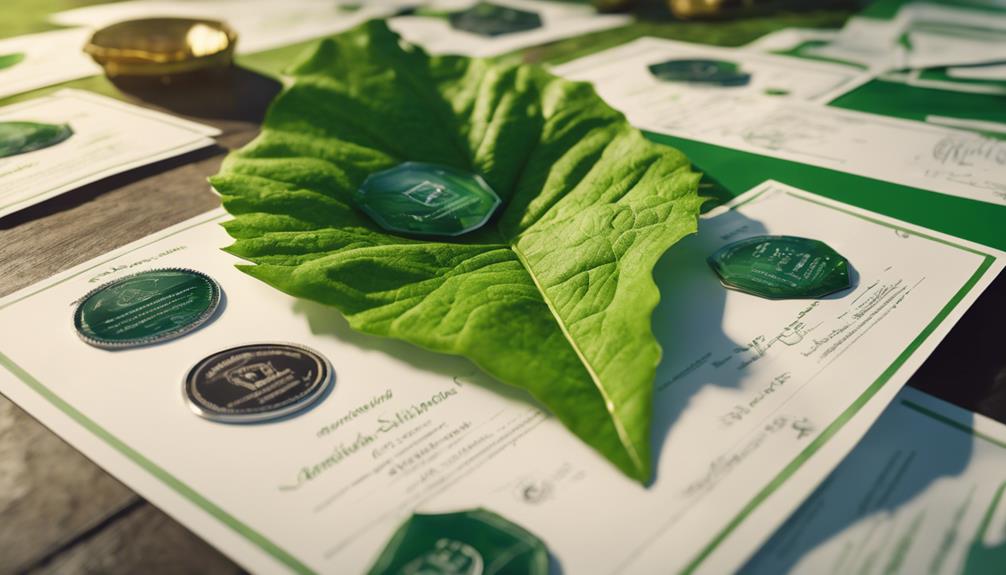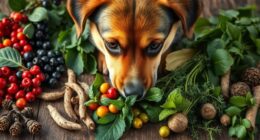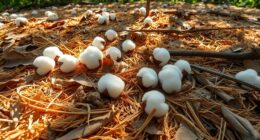You're surrounded by a world of wild edibles in the UK, from cockles and wild garlic to velvet shank mushrooms and winter cress, waiting to be foraged and savored in your kitchen. Foraging offers a fresh, seasonal, and sustainable way to connect with nature and discover diverse flavors. From winter's cockles and crow garlic to summer's velvet shank and watercress, each season brings new delights. By exploring responsibly and safely, you can reveal a world of flavors and ingredients. As you explore the UK's wild foods, you'll uncover more surprising flavors and ingredients, just beyond the next hedgerow.
Key Takeaways
- In the UK, you can forage for wild edibles like cockles, cod, common sorrel, and crow garlic in winter, and velvet shank mushrooms in summer.
- Spring offers a flavorful journey with wild garlic, sorrel, nettles, ground ivy, yarrow, cow parsley, lime blossom, chickweed, and dandelion.
- Woodlands are treasure troves for edible mushrooms, nuts, and berries, while hedgerows are rich in wild herbs, fruits, and nuts.
- Coastal regions yield sea vegetables, shellfish, and coastal plants like sea beet and samphire, and oyster mushrooms can be found in woodlands.
- Foraged ingredients can be used to make jams, jellies, pies, and syrups, and add unique flavors to culinary creations.
What Is Foraging?
When you venture into the woods, forests, or coastal areas to gather wild food, you're practicing foraging, an ancient tradition that connects you with nature and promotes self-sufficiency.
Foraging involves identifying and harvesting edible wild plants, fruits, nuts, mushrooms, and other natural resources. This practice not only provides you with fresh, seasonal ingredients but also enhances your outdoor experiences.
By foraging, you'll develop a deeper appreciation for the natural world and the diverse flavors it has to offer. As you explore the UK countryside, you'll discover a wide range of wild food, from berries and herbs to seaweed and shellfish.
Foraging is an excellent way to connect with nature and tap into the rich flavors of the British wilderness. By understanding what foraging is, you'll be better equipped to explore the world of wild food and make the most of your outdoor adventures.
Foraging Responsibly in the UK

As you start your foraging adventures in the UK, it's essential to prioritize responsible practices to guarantee a sustainable and respectful relationship with the natural world. This means positively identifying wild plants, obtaining necessary permissions, and collecting only from abundant sources. You should always leave enough for wildlife, avoid damaging habitats, and never consume unknown plants.
Here are some essential guidelines to keep in mind:
| Responsible Foraging Practice | Why It's Important | Tips for Success |
|---|---|---|
| Identify plants correctly | Avoid mistakenly eating toxic lookalikes | Consult multiple field guides and expert foragers |
| Obtain necessary permissions | Respect private land and protected areas | Research local regulations and seek landowner permission |
| Collect sustainably | Preserve ecosystems for future generations | Harvest only what you need, leaving enough for wildlife |
Monthly Wild Food Calendar

In the UK, you can forage for a diverse range of wild foods throughout the year, with each month offering its unique seasonal bounty. By grasping what's in season, you can guarantee a constant supply of fresh, free, and flavorful ingredients for your kitchen.
Here are some highlights from the UK's monthly wild food calendar:
- Winter months (Jan-Feb): Look out for cockles, cod, common sorrel, brown crab, and crow garlic.
- Summer delights: Velvet shank, watercress, wild garlic, wood sorrel, and winter cress are just a few of the many options.
- Autumn treats: Velvet shank, wild cabbage, winter cress, whiting, and wild venison are just some of the seasonal goodies.
When it comes to urban foraging, you might be surprised at the variety of spring plants that can be found in the city. From common sorrel to wild garlic, there are plenty of wild foods waiting to be discovered. By keeping an eye on the monthly calendar, you can make the most of Britain's best wild foods and enjoy a year-round supply of fresh, foraged ingredients.
Seasonal Foraging Guide

As you explore the world of foraging, you'll discover that each season brings its own unique treasures. From the first tender shoots of spring to the abundant harvests of summer, you'll uncover a world of flavors and textures that will elevate your culinary game.
Let's take a closer look at the seasonal delights that await you, and uncover the secrets of Britain's best wild foods.
Spring Delights Uncovered
You'll find that spring's awakening brings a fresh wave of flavors to the UK's countryside, from the pungent aroma of wild garlic to the tangy zing of sorrel. As the season unfolds, you'll discover a world of edible delights, each bursting with nutrients and flavor.
Some of the top spring foraging finds include:
- Wild garlic, with its pungent aroma and flavor
- Sorrel, adding a tangy zing to salads and sauces
- Nettles, packed with vitamins and minerals
In the UK, spring offers an abundance of fresh shoots, leaves, and flowers for culinary exploration. You can explore new herbs like ground ivy, yarrow, and cow parsley, each with its unique flavor profile.
From the vibrant flavors of lime blossom and chickweed to the earthy tones of dandelion, every bite is a taste sensation. So, get ready to set off on a flavorful journey through the UK's countryside, where nature's bounty awaits!
Summer Bounty Beckons
Summer's warmth reveals a treasure trove of wild foods across the UK, with velvet shank mushrooms, watercress, and wood sorrel waiting to be discovered in the countryside.
As you venture out, you'll find an abundance of flavorful options like wild garlic and winter cress, perfect for adding some zest to your summer dishes.
The UK countryside is teeming with edible plants and herbs, including velvet shank and wood sorrel, just waiting to be foraged.
As you explore the summer bounty, you'll discover a variety of nutritious and tasty wild foods like watercress and winter cress.
Take advantage of the season's offerings and indulge in the rich flavors of wild garlic, velvet shank mushrooms, and other summer treasures.
Whether you're a seasoned forager or just starting out, the summer season is an ideal time to get outside and experience the thrill of foraging for Britain's best wild foods.
Foraging Safety Essentials

When venturing out to forage, it's important that you prioritize caution and follow essential safety guidelines to avoid mistakenly consuming toxic plants.
Never eat a wild plant without being 100% certain of its edibility. It's essential to remember that some plants can be toxic, even poisonous, and can cause serious harm or even death.
To guarantee your safety while foraging, keep the following essentials in mind:
- Always use a reliable field guide for plant identification
- Verify the edibility of plants through multiple trusted sources before consuming them
- Consider taking foraging courses led by experts for in-depth knowledge and safety tips
Wild Food Recipe Ideas

As you explore the world of wild food recipe ideas, you'll discover a plethora of summer harvest delights and wild berry creations that will elevate your culinary skills.
From sweet treats to savory dishes, you'll find inspiration in the unique flavors and textures of foraged ingredients.
Now, let's take a closer look at how you can incorporate these wild foods into your cooking repertoire.
Summer Harvest Delights
You'll discover a world of flavors and textures in the wild foods of summer, from peppery watercress and tangy wood sorrel to the earthy sweetness of velvet shank mushrooms. As you venture out foraging, you'll uncover a treasure trove of ingredients to elevate your summer dishes.
Here are just a few ideas to get you started:
- Create a invigorating salad with watercress, wild garlic, and a tangy wood sorrel dressing
- Add earthy velvet shank mushrooms to your summer barbecues for a flavorful twist
- Infuse your summer soups with the vibrant flavor of wild garlic pesto
Summer foraging allows you to connect with nature while enjoying the freshest, seasonal produce. By incorporating wild foods into your summer recipes, you'll experience the thrill of the hunt and the satisfaction of creating something truly unique.
Wild Berry Creations
Now that you've savored the flavors of summer's wild delights, turn your attention to the sweet treats that await you in the wild berry patch, where bilberries, sloes, and elderberries ripen with the promise of delectable desserts and preserves.
As you forage for these plants, you'll discover the unique flavors and nutrients they bring to your dishes. In early spring, get ready to create mouth-watering wild berry creations that showcase the diversity of these foraged ingredients.
Try your hand at making jams, jellies, pies, and syrups that highlight the natural sweetness of these wild berries. Recipes like bilberry and almond streusel cake, elderberry cordial, and sloe gin are just a few ideas to get you started.
Regional Foraging Hotspots

From the ancient woodlands of Scotland to the rugged coastlines of Cornwall, diverse regional foraging hotspots await discovery across the UK. As you venture out, you'll find that each region offers a unique array of wild foods.
- Woodlands are treasure troves for edible mushrooms, nuts, and berries
- Hedgerows are rich in wild herbs, fruits, and nuts
- Coastal regions yield sea vegetables, shellfish, and coastal plants like sea beet and samphire
You might stumble upon oyster mushrooms in woodlands or discover hidden coves teeming with sea beet along the coast. Urban areas, too, hold secrets, with stinging nettles, chickweed, and urban mushrooms waiting to be found in parks and green spaces.
As you explore these regional hotspots, you'll realize that foraging in the UK is a rewarding and varied experience. With each new discovery, you'll uncover the diversity of Britain's wild foods, making every outing a thrilling adventure.
Frequently Asked Questions
What Foods Can You Forage in the Uk?
You can forage a variety of wild foods in the UK, including nettles, wild garlic, blackberries, and hazelnuts, as well as mushrooms, sea vegetables, and fruits like sloes and crab apples in the countryside. When foraging, it’s important to properly identify plants and mushrooms, as mistakes can lead to serious health risks. Always ensure you leave enough behind to allow nature to replenish, promoting sustainability for future foragers. To forage safely in the UK, familiarize yourself with local guidelines, seek expert advice if unsure, and be mindful of any legal restrictions in certain areas. Additionally, be respectful of private property and always seek permission if foraging on land that doesn’t belong to you. Remember that certain protected species are off-limits, so be well-informed about what is safe and legal to gather. With the proper knowledge and care, you can responsibly forage in the UK while enjoying the country’s rich and diverse natural resources.
What Can You Eat in the Forest Uk?
As you wander through the UK forest, imagine stumbling upon a hidden treasure trove of flavors. You can eat a variety of wild delights, from earthy chanterelle mushrooms and tangy wild garlic to sweet bilberries and crunchy hazelnuts, all waiting to be discovered.
What Weeds Can You Eat in the Uk?
You can forage and eat common weeds like chickweed, nettles, dandelions, and sorrel in the UK, which are rich in vitamins, iron, and offer a tangy flavor to your dishes, making them a nutritious and tasty addition.
What Food Can You Forage in Scotland?
In Scotland, you can forage for wild garlic, chanterelle mushrooms, and elderberries, as well as seaweed like dulse and carragheen along the coast, and wild herbs like thyme and sorrel in the countryside.
Conclusion
As you venture into the wild, the thrill of the hunt coursing through your veins, remember that the UK's hidden culinary treasures await. From the tartness of wild garlic to the sweetness of blackberries, every season brings a new wave of flavors to discover.
So, lace up your boots, grab your basket, and indulge in the bounty of Britain's wild foods. The great outdoors is your pantry, and the feast is waiting – go forage!

